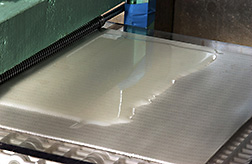|
Read the
magazine
story to find out more. |
|

A continuous
biodegradable protein film begins to form using the new ARS film-making
process. Click the image for more information about it.
|
|

|
Edible Films Made From Dairy, Biofuel
Byproducts
By Linda Tokarz June
5, 2007
Got film? A method developed by Agricultural Research Service (ARS)
scientists uses byproducts—not only from dairy processing, but also from
biofuel production—to create biodegradable protective films.
The technology was developed by research leader
Peggy
M. Tomasula and her colleagues at the ARS
Eastern
Regional Research Center's
Dairy
Processing and Products Research Unit in Wyndmoor, Pa. They found that
combining the milk protein casein with water and glycerol, a byproduct of
biofuel production, produces a water-resistant film that can be used as an
edible coating for food products.
The scientists used carbon dioxide as an environmentally friendly
solvent to isolate dairy proteins from milk, instead of harsh chemicals or
acids that can be difficult to dispose of, according to Tomasula. Carbon
dioxide (CO2) is another byproduct of the glucose fermentation that is used to
make ethanol. Using CO2 makes the edible film more water-resistant and
biodegradable.
The resulting food coatings are glossy, transparent and completely
edible. Like conventional food packaging, edible films can extend the shelf
life of many foods, protect products from damage, prevent exposure to moisture
and oxygen and improve appearance. By using renewable resources instead of
petrochemicals, the scientists can create more biodegradable products and
reduce waste.
Tomasula has been working with food technologist
Kirsten
L. Dangaran and chemist
Phoebe
X. Qi to improve the appearance and protective properties of the casein
films.
At one point in the production process, CO2 dissolves into the milk,
decreasing its pH level and causing casein to form particles of a substance
known as CO2-casein. The researchers found that decreasing the size of the
CO2-casein particles improved the films' ability to block moisture and
increased their glossiness.
They also found that coating a low-density polyethylene film with the
CO2-casein increased the film's ability to block oxygen permeation. Adjustments
like these could make the films more competitive with existing, less
eco-friendly products.
Read more
about the research in the May/June 2007 issue of Agricultural Research
magazine.
ARS is the U.S. Department of
Agriculture's chief scientific research agency.